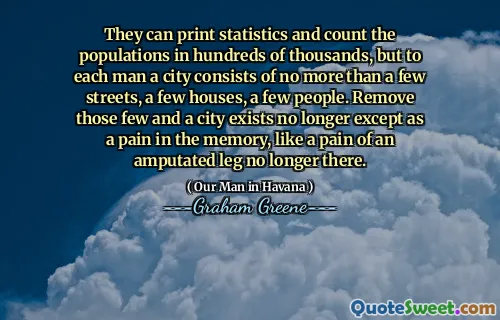
They can print statistics and count the populations in hundreds of thousands, but to each man a city consists of no more than a few streets, a few houses, a few people. Remove those few and a city exists no longer except as a pain in the memory, like a pain of an amputated leg no longer there.
This quote deeply explores the essence of human connection and the true meaning of community. It highlights a fundamental truth: while statistics and data can quantify populations, they fail to capture the intimate, personal experience of living within a city. For each individual, a city isn't just a collection of streets, buildings, or numbers—it's a mosaic of relationships, memories, and everyday interactions. When you peel away these personal layers, the physical structure of the city remains, but its soul dissipates.
The analogy of an amputated leg underscores the profound loss associated with the removal of those personal elements. Just as the leg might disappear physically but leave behind ongoing pain or phantom sensations, the city, devoid of its human stories and connections, becomes a hollow shell. This suggests that the identity of a place is rooted in its inhabitants and their stories, not just in its physical infrastructure.
The reflection prompts us to consider a broader perspective on urban life and the importance of community, human relationships, and individual experiences in creating meaningful spaces. It serves as a reminder that the essence of a city—its culture, its spirit—is carried by its people. Indeed, cities are living entities shaped by the lives they host, and without the people—their stories, struggles, and triumphs—they lose their vibrancy and significance.
Graham Greene seems to evoke a profound understanding that summing up a city in mere statistics diminishes its true value. It's a call to cherish the personal ties and stories that make a place truly alive. Without these, a city is just a shell of its former self, a painful memory that fades with time and loss.






